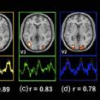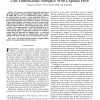42 search results - page 2 / 9 » Exploring functional connectivity in fMRI via clustering |
IPMI
2003
Springer
14 years 5 months ago
2003
Springer
We explore a new paradigm for the analysis of event-related functional magnetic resonance images (fMRI) of brain activity. We regard the fMRI data as a very large set of time serie...
ISBI
2008
IEEE
14 years 5 months ago
2008
IEEE
Most clustering algorithms in fMRI analysis implicitly require some nontrivial assumption on data structure. Due to arbitrary distribution of fMRI time series in the temporal doma...
TMI
2008
13 years 4 months ago
2008
We propose a new method for detecting activation in functional magnetic resonance imaging (fMRI) data. We project the fMRI time series on a low-dimensional subspace spanned by wave...
ICASSP
2008
IEEE
13 years 11 months ago
2008
IEEE
Graphical models of brain functional connectivity have matured from con rming a priori hypotheses to an exploratory tool for discovering unknown connectivity. However, exploratory...
ICASSP
2007
IEEE
13 years 11 months ago
2007
IEEE
As dynamic connectivity is shown essential for normal brain function and is disrupted in disease, it is critical to develop models for inferring brain effective connectivity from ...


